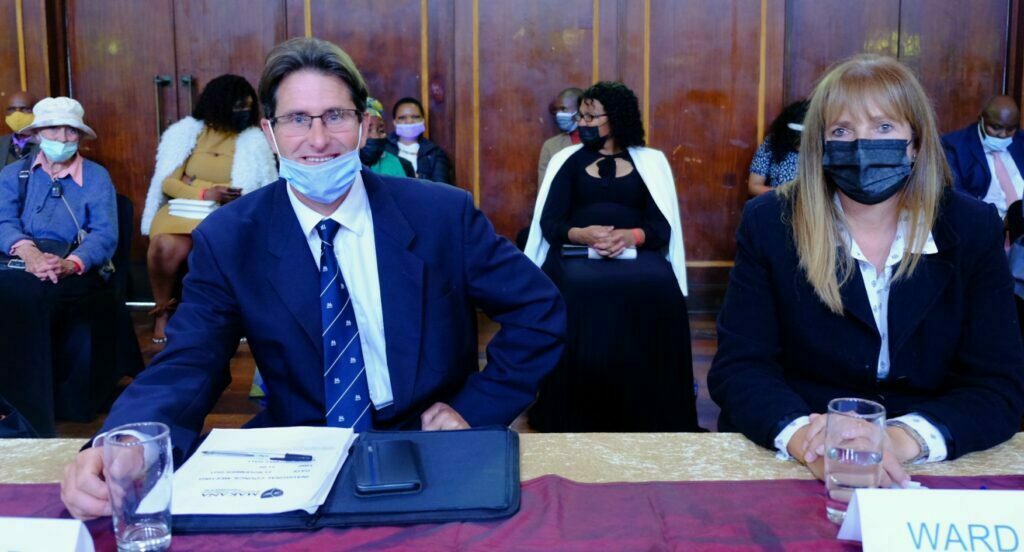By GEOFF EMBLING, Democratic Alliance (DA) Ward 4 councillor
Below are some of the questions and suggestions put to the director and managers of Makana Municipality at the Infrastructure Portfolio meeting on Wednesday 9 February:
Question: Why does the municipality blame turbidity in the system for low water volumes from the dams on the western side of town and Waainek Water Treatment Works (WTW), and why did the city not have water cuts during times of heavy rainfall in the past.
Answer: The manager of water said that the turbidity is due to high levels of sediment in Howieson’s Poort dam, and because of the increased population of +/- 100 000 residents. The combined water sources are not sufficient to supply the whole town, which is why the James Kleynhans Water Treatment Works on the eastern side of the city, is being upgraded. He said Howieson’son’s Poort pump station only needs one pump, which generates 100 litres/second, and that station has only ever used one pump at a time – the other pumps are for backup. Secondly, the flocculant that the municipality ordered was not suitable for the sediment levels after the rainfall, and it takes ten days to order the correct flocculant.
Supply chain management was a recurring issue at the meeting. For example, a grader that needs a new tyre can take a long time to source even though it could be easily acquired. Supply chain management (SCM) and the surrounding bureaucracy will be looked into. The director was asked to provide a service delivery audit report on water at the next infrastructure meeting.
Suggestion: A request was made that the municipality assesses the total amount of water wasted. This would be an estimate based on the total volume of water (litres) pumped from James Kleynhans WTW plus Waainek WTW and the amount of money collected from water rates. The left-over water in the equation would be due to leakage in the system plus unpaid bills. This would give an estimate of how much water is wasted.
Answer: The manager responded that in Phase 2 and 3 of the water upgrades, the municipality plans to install Zoom meters at various key points, which will be more accurate for determining water loss. Water loss was mentioned a few weeks ago in council by the chairman of the internal audit committee, Prof Plaatjies, who estimated it as R7.9-million for the last financial year, and electricity wastage and illegal connections were estimated at over R8-million).
Question: What happened to the two pumps fHowieson’son’s Poort pump station, and when will they be returned?
Answer: The manager said last year all three pumps were in Howieson’s Poort pump station. But the municipality tried to pump water from the dam during the dry period, and because the dam was only 20 per cent full, the negative suction of the pump (low pressure) caused the impellors to break.
The two pumps were sent for servicing. Fixing the two pumps will cost 80 per cent of the money needed to buy one new pump. Instead of fixing them, the municipality may purchase one new pump. Council noted that this is urgent because the town is in trouble if anything goes wrong with the one remaining pump. The director said that a report on the status of the pumps was being assessed, and she and the manager will ask for the report to be made public.
Question: Could Grahamstown-Makhanda use local engineers willing to help with the crisis.
Answer: It was stated by the Speaker and Director that this may get complicated and that a set framework must be developed so that engineers who have volunteered their services do not take over and pull against the municipality’s strategy. Forums will be needed to discuss this.
Other infrastructure items such as electricity, housing, sewerage and drains were discussed, notably:
• Load shedding causes the timers on lights to change, which is why lights are on and off at odd times.
• Informal settlements encroach onto areas near roads and use illegal electricity. By-laws to prevent this are not enforced, and traffic officers are the “peace officers” who are supposed to enforce by-laws. But the traffic department is in chaos, and by-laws are not enforced. It was requested that the council discusses the adoption of additional peace officers such as police and fire department officials, who can then implement by-laws.
• Some roads are so bad that they will need to be graded and will be better off as dirt roads, but there is only one grader in operation, and it is in bad condition.
• There are two teams instead of four teams for roads and one team instead of two teams for stormwater. The municipality is currently collaborating with the District Municipality, which is in far better shape than the local municipality, for a master plan for stormwater.
• There was a R6-million rollover for infrastructure for the last financial year (from the municipal infrastructure grant), which means that Makana could have spent R6-million more on infrastructure projects such as roads, sewage, and water if the municipality had the skills, planning and personnel to implement the projects. It is likely that the money is lost and won’t be allocated because it was not used.
In summary, the director and managers of infrastructure were enthusiastic about discussing matters and finding solutions.


